Geology Reference
In-Depth Information
Dragon's Back Pressure Ridge Forcing and Topographic Response
Distance NW along Dragon's Back (km)
Distance NW along Dragon's Back (km)
0
1
2
3
4
0
1
2
3
4
A
D
Normalized Channel Steepness
3
10
5
0
Rock-uplift rate (mm/yr)
2
1
0
100
50
Landslide Scar Density (m
-1
)
Cumulative Rock Uplift (m)
B
E
0.04
0.02
0
1
0.5
0
0
Hillslope Gradient (m/m)
C
F
Local Relief (m)
6
40
2
0
0
30
60
90
120
0
30
60
90
120
Time (k.y.)
Time (k.y.)
Fig. 9.21
Rock uplift and geomorphic metrics at Dragon's Back pressure ridge.
Distance is measured toward the northwest and starts at the inception of uplift. Time is based on an assumed
San Andreas slip rate of 33 mm/yr or 1 km in 30 kyr. Topographic data were extracted from a 1-m DEM.
A. Rock-uplift rate along the crest of the pressure ridge. B. Cumulative rock uplift along the crest. C. Local topographic
relief measured in a 50 m radius: average relief (solid line) and 95% bounds (shaded area). D. Normalized channel
steepness based on a reference concavity of 0.68 (mean of the entire data set). Only catchments for which a linear
log area-slope trend could be identified that spanned more than an order of magnitude of catchment area were
included. E. Landslide scar density. F. Hillslope gradients. Modified after Hilley and Arrowsmith (2008).
climate, lithology, or vegetation, promise to shed
more insight on tectonic-geomorphic linkages.
the tip of the underlying fault migrated with
each successive rupture event. Simultaneously,
especially in the early stages of development,
these growing folds progressively increase in
amplitude and breadth with each successive
earthquake. As their flanks rise above local base
level, they are attacked by erosional surface
processes, and their pristine surfaces begin to
be modified. Meanwhile, as their noses propa-
gate laterally, the resultant uplift influences the
gradients and geometries of nearby fluvial
systems. Thus, two rather different responses to
growing folds are potentially recorded in the
geomorphological record: in one, the shape of
the fold is modified by surface processes; in the
other, the actual growth of the fold modifies
the surface processes (Keller
et al.
, 1999). The
degree of surface modification may be an indication
of the age of various parts of a fold and the local
rate of deformation, whereas river patterns with
respect to the fold may reveal their interactions
over time. Analysis of these interactions can
Growing folds
Whether they are laterally propagating or have
rather fixed tips, growing folds represent a
special type of transient landscape, because,
along their length, progressive changes occur in
their geometric attributes, such as the magnitude
of differential uplift or the slope of their limbs.
Perhaps most importantly, laterally propagating
folds can provide a robust space-for-time substi-
tution, and, when the ages of uplifting surfaces
are known, rates of processes can be defined.
As described previously, as faults accumulate
displacement, they commonly increase the size
and length of their rupture surface. The
plunging noses of hanging-wall anticlines and
footwall synclines that develop in conjunction
with either emergent or blind thrusts would,
therefore, be expected to propagate laterally as

































































































































































































































